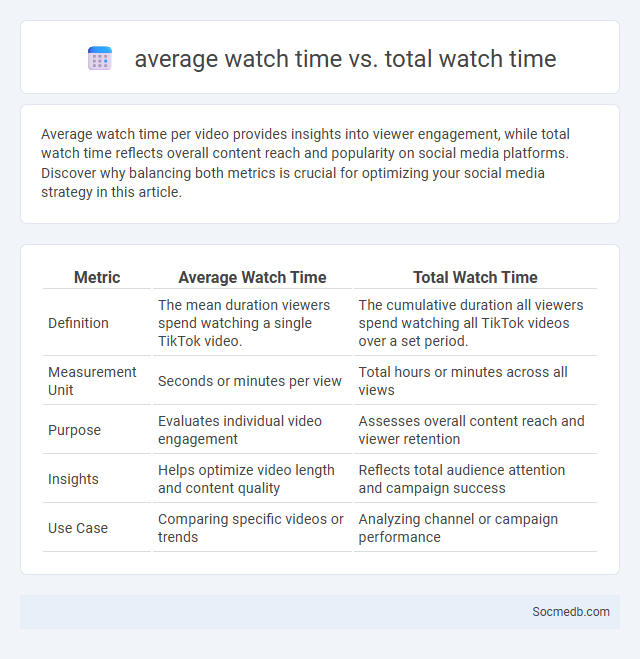
Photo illustration: average vs total watch time
Average watch time per video provides insights into viewer engagement, while total watch time reflects overall content reach and popularity on social media platforms. Discover why balancing both metrics is crucial for optimizing your social media strategy in this article.
Table of Comparison
| Metric | Average Watch Time | Total Watch Time |
|---|---|---|
| Definition | The mean duration viewers spend watching a single TikTok video. | The cumulative duration all viewers spend watching all TikTok videos over a set period. |
| Measurement Unit | Seconds or minutes per view | Total hours or minutes across all views |
| Purpose | Evaluates individual video engagement | Assesses overall content reach and viewer retention |
| Insights | Helps optimize video length and content quality | Reflects total audience attention and campaign success |
| Use Case | Comparing specific videos or trends | Analyzing channel or campaign performance |
What is Average Watch Time?
Average watch time measures the mean duration viewers spend watching a video on social media platforms, indicating content engagement and viewer retention. It is calculated by dividing the total watch time by the number of views, providing insights into how effectively a video holds audience attention. High average watch time often correlates with improved algorithm rankings and increased content visibility.
What is Total Watch Time?
Total Watch Time measures the cumulative amount of time viewers spend watching your videos across social media platforms, reflecting content engagement and viewer retention. Platforms like YouTube prioritize videos with higher Total Watch Time, boosting visibility and ranking in search results. Understanding and optimizing this metric helps you create compelling content that keeps your audience engaged longer.
Defining Watch Time in Video Analytics
Watch time in video analytics measures the total amount of time viewers spend watching your video content across social media platforms, reflecting engagement and content relevance. High watch time indicates that your videos successfully capture audience attention and encourage longer viewing sessions. Optimizing watch time can improve your video's ranking in algorithms, leading to greater reach and visibility.
Key Differences: Average vs Total Watch Time
Average watch time measures how long viewers typically engage with your content per session, reflecting individual interest and video quality. Total watch time aggregates all viewing sessions' duration, indicating overall content reach and audience retention. Understanding both metrics helps optimize your social media strategy by balancing viewer engagement with content distribution effectiveness.
How Platforms Calculate Watch Time Metrics
Social media platforms calculate watch time metrics by measuring the total duration users spend viewing videos or content on the platform, including partial and completed views. Algorithms analyze factors such as viewer engagement, video length, and playback behavior to determine the relevance and popularity of content. Understanding how watch time is measured can help you optimize your videos to increase visibility and boost your content's performance.
Why Average Watch Time Matters
Average watch time is a critical metric for social media algorithms, influencing content visibility and reach across platforms like YouTube, Instagram, and TikTok. Higher average watch time signals strong viewer engagement, increasing the likelihood that algorithms promote the video to a broader audience. Brands and creators benefit from improved watch time as it directly correlates with audience retention, better ad revenue, and enhanced organic growth.
The Importance of Total Watch Time for Creators
Total watch time is a crucial metric for social media creators as it directly influences platform algorithms, enhancing content visibility and audience growth. Your ability to keep viewers engaged longer increases the likelihood of monetization opportunities and brand partnerships. Prioritizing content that maximizes viewer retention ensures sustained relevance and competitive advantage in the digital landscape.
Watch Time’s Impact on Algorithm Rankings
Watch time plays a crucial role in social media algorithm rankings by signaling content quality and viewer engagement to the platform. When your videos maintain high watch time, the algorithm prioritizes them, increasing visibility and reach across user feeds. Maximizing watch time ensures your content is promoted, driving more interactions, followers, and overall growth.
Best Practices to Increase Watch Time
To increase watch time on social media, create engaging and high-quality content that captures viewers' attention within the first few seconds. Utilize analytics to understand your audience's preferences and tailor video length and topics accordingly, ensuring your content remains relevant and compelling. Incorporate clear calls to action to encourage viewers to stay longer and interact with your videos, boosting overall engagement and watch time.
Interpreting Watch Time Data for Growth
Analyzing watch time data on social media platforms reveals viewer engagement patterns and content preferences that drive channel growth. Higher average watch time correlates with improved algorithmic promotion and increased organic reach, making it essential for content creators to monitor this metric closely. Optimizing video length and pacing based on watch time insights can significantly boost audience retention and overall growth.
 socmedb.com
socmedb.com